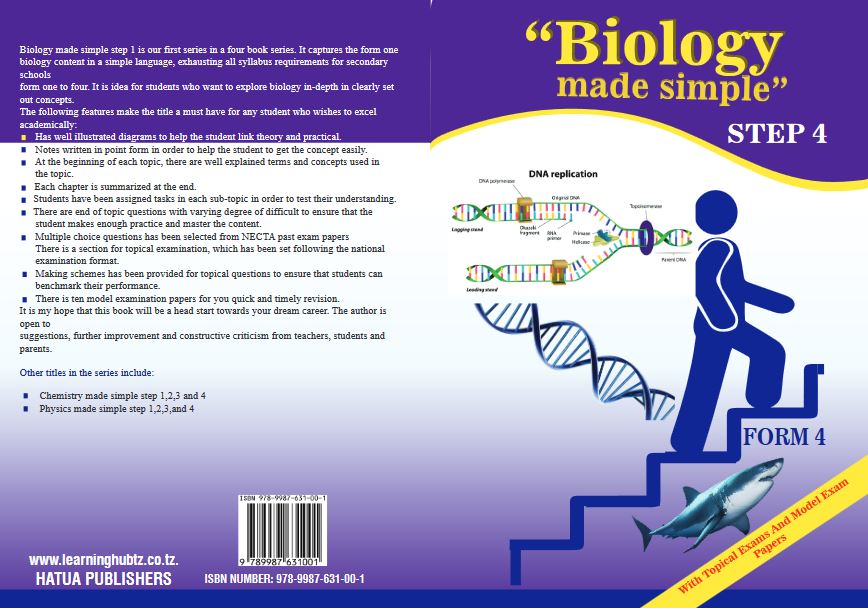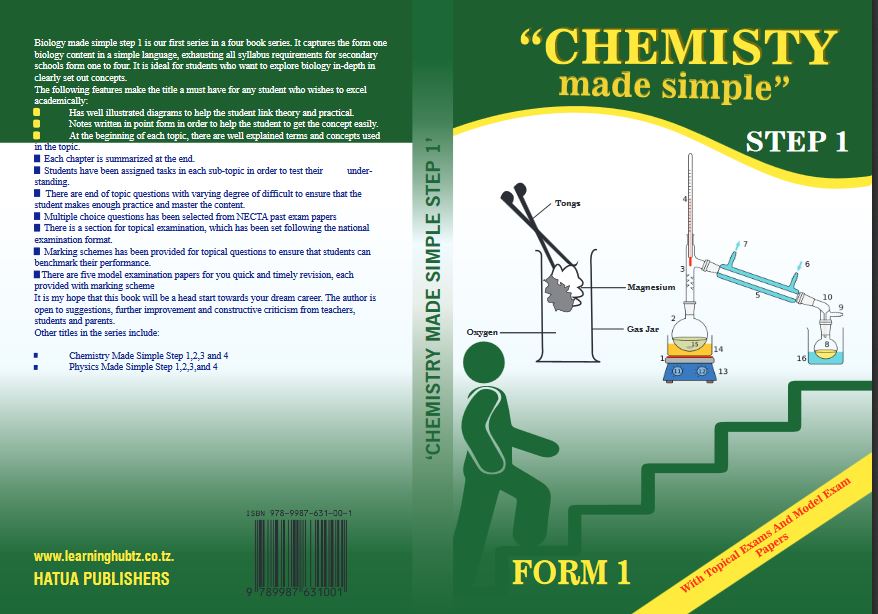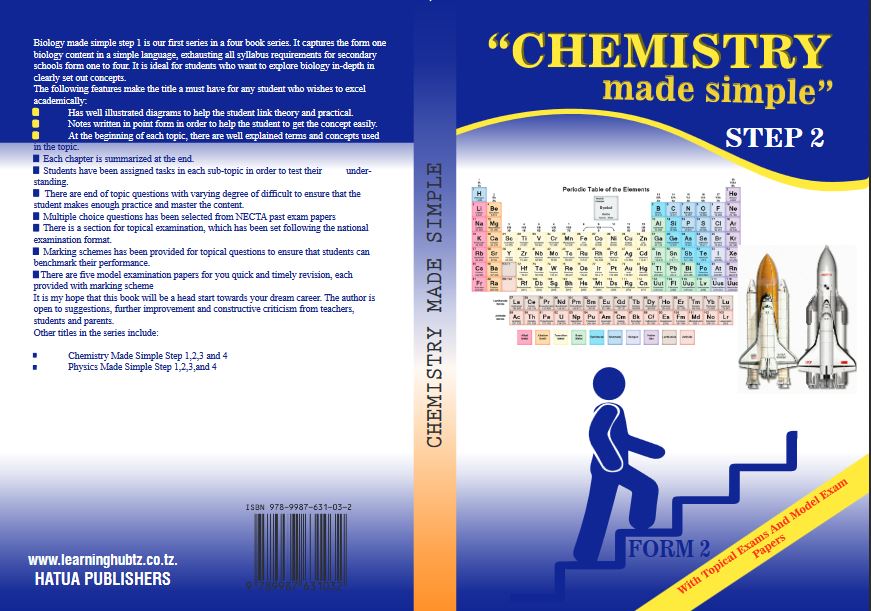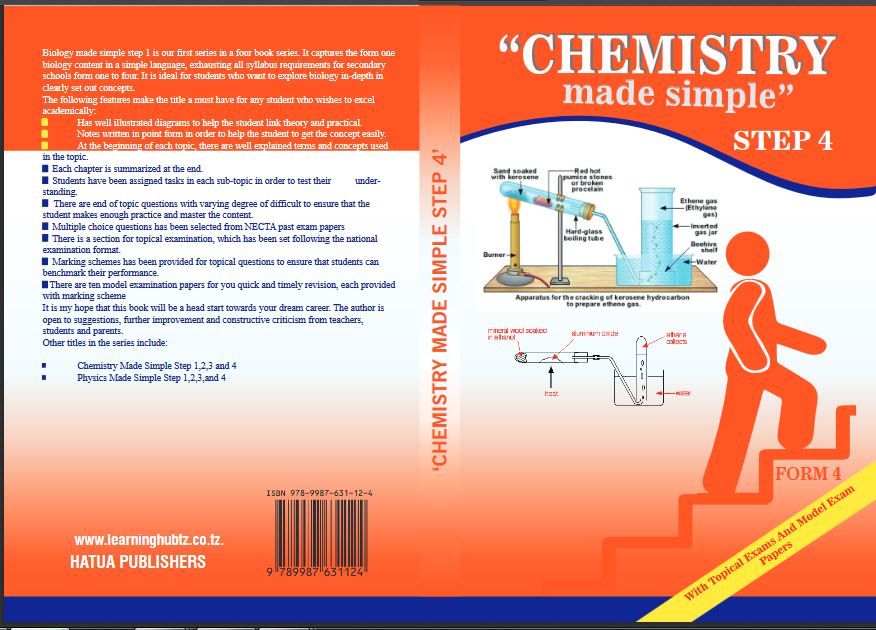
FORM ONE BIOLOGY EXAM SERIES 215
FORM ONE BIOLOGY EXAM SERIES 215

FORM ONE BIOLOGY EXAM SERIES 214
FORM ONE BIOLOGY EXAM SERIES 214
THE PRESIDENT’S OFFICE
REGIONAL ADMINISTRATION AND LOCAL GOVERNMENT
BIOLOGY FORM ONE TERMINAL EXAMINATION
CODE 033
TIME: 2:30 HOURS
INSTRUCTIONS.
- This paper consists of section A, B and C with the total number of ten(10) questions
- Answer all questions in each section
- Section A carries (15) marks, section B (70) marks and section C carries (15) marks
- All writing must be in blue/black ink except drawing which must be in pencil
- Cellular phones and any unauthorized materials are not allowed in the assessment room.
SECTION A (15 Marks)
Answer all questions in this section
1. For each of the items (i) – (x) choose the correct answer from among the given alternatives and write its letter beside the item number in the answer sheet provided
- The basic unit of life is called a:
A. Tissue
B. Organ
C. System
D. Cell
- The study of insects is called:
A. Mycology
B. Herpetology
C. Entomology
D. Zoology
- Which science is closely related to biology and helps in understanding the chemical basis of life?
A. Physics
B. Chemistry
C. Geology
D. Astronomy
- The first step in the scientific method is:
A. Formulating a hypothesis
B. Making an observation
C. Analyzing data
D. Conducting an experiment
- The scientific method is valuable because it:
A. Guarantees accurate results
B. Provides a systematic way of asking and answering questions
C. Eliminates the need for creativity
D. Allows scientists to skip the experimental stage
- Which of the following is NOT a common laboratory apparatus?
A. Test tube
B. Beaker
C. Telescope
D. Graduated cylinder
- One important biology laboratory safety rule is:
A. Always wear closed-toed shoes
B. Ignore warning labels
C. Run around the lab when excited
D. Work independently at all times
- The symbol of a skull and crossbones often indicates:
A. A flammable substance
B. A radioactive material
C. A poisonous substance
D. A slippery surface
- Which is a key aim of providing first aid?
A. To prevent further injury or illness
B. To diagnose the underlying condition
C. To provide long-term medical treatment
D. To replace the need for emergency care
- If someone is bleeding severely, the first step in first aid is to:
A. Clean the wound
B. Apply direct pressure to the wound
C. Elevate the wound
D. Apply ice
2. Match the item in Column A with its primary use in Column B.
| Column A | Column B |
|
|
SECTION B: 70 MARKS
3. (a) Define the word “biology”
(b) Write down 3 importance of studying biology
- List down 4 branches of biology
4.(b) Differentiate between botany and zoology
(b) Mention characteristics of living things (7)
5.(a) Differentiate between;
- Specimen and model
- Temperature and body temperature
- Fact and theory
- Explain one function of each of the following biology laboratory apparatus and equipments.
- Test tube holder
- Test tube rack
- Petri dish
- Motor and pestle
- Test tube brush
- a) Define the following terms
- first aid
- first aid kit
b) Who should give first Aid?
c) Give the benefits of giving first Aid to an accident victim.
7. (a) state the steps that should be taken to prevent yourself from getting infections when giving first aid.
(b) Mention three specimens that can be found in biology laboratory
8. Outline the procedure of giving first Aid to an accident victim
a) Snake bites
b) Electric shock
9. (a) what are muscles cramps
b) Give the causes of muscle cramp
c) Mention ways of preventing muscle cramps
10. (a)Mention ten common accidents which can occur at home.
(b) Identify six items found in a first aid kit an state their uses.
FORM ONE BIOLOGY EXAM SERIES 167
FORM ONE BIOLOGY EXAM SERIES 167
PRESIDENT OFFICE REGIONAL ADMNISTRATION
AND LOCAL GOVERNMENT
SECONDARY EXAMINATION SERIES
COMPETENCE BASED ASSEMENT
BIOLOGY FORM ONE
TERMINAL EXAMS-MAY– 2023
033
Time: 2:30 Hours
INSTRUCTIONS
- This paper consists of sections A, B and C with a total of ten (10) questions.
- Answer all questions
- Section A and C carry fifteen (15) marks each and Section B carry seventy (70) marks.
- All writing must be in blue or black ink except drawing which must be in pencil.
- Cellular phones and any unauthorized materials are not allowed in the assessment room.
SECTION A
- For each of items (i) – (x) choose the correct answer from among the given alternatives and write its letter in box provided.
- Which organism below is a prokaryote?
- Zea mays
- Vibrio cholerae
- Rhizopus
- Amoeba
- Virus
- A sexual transmitted disease characterized by yellow discharge from penis or vagina and pain during urination in males is;
- Candidiasis
- Gonorrhoea
- Syphilis
- Trichomoniasis
- Hepatitis.
- Which of the following is a site for ribosome formation?
- Nucleus
- Rough endoplasmic reticulum
- Golgi body
- Nucleolus
- Cytoplasm
- Preparing specimen for sectioning and viewing is termed as;
- Staining
- Sectioning
- Resolution
- Magnification
- Fixation.
- The study of small organisms is termed as;
- Virology
- Mycology
- Micro-biology
- Parasitology
- Genetics.
- The best way to control typhoid is through;
- Vaccination
- Treatment
- Maintain personal and environmental hygiene
- Proper disposal of feaces
- Water treatment.
- The purpose of a control experiment in investigation is;
- Identify the problem
- Test hypothesis
- Display results
- Confirm results
- Predict results
- Which of the following diseases is caused by bacteria?
- Sleeping sickness
- Malaria
- Aids
- Tuberculosis
- Askariasis
- The outer living structure of a cell is;
- Cell wall
- Cytoplasm
- Cell membrane
- Nuclear membrane
- Ectoplasm
- In which of the following tissues can rapid mitotic cell division be seen?
- Nerve cell
- Heart
- Embryonic
- Muscles
- Epidermal
- The following are specialized cells and their adaptations. Much each cell with the adaptions
| CELL | ADAPTATIONS |
|
|
SECTION B. 70 MARKS. ANSWER ALL QUESTIONS FROM THIS SECTION.
- (a) State the cell theory
(b) Explain two differences between prokaryotic and eukaryotic cell
(c ) Name the organelle that performs the following functions
- Synthesis of protein
- Transporting cell secretions
- Controlling vital processes in the cell
- Controlling materials entering and leaving the cell
4. (a)Waste is any substance that is no longer in use, the teacher said. Mwajuma asked to a teacher to explain the meaning of waste disposal. If a teacher chose you what answer did you respond to Mwajuma?
(b)Poor waste disposal has led to many effects. Continue telling Mwajuma the effects of poor waste disposal (use 4 effects)
5. (a) Sophia does not know the meaning of some biological phenomena. As the biologist help Sophia to explain the meaning of these biological phenomena which are unknown.
i. Cell differentiation
ii. An organ
iii. A system
(b)What are three examples of specialized cells of animals?
6. Study the diagram of the following organisms carefully and answer the questions that follow:
(a) Identify the organisms above by their common Names:
| | |
R is: _________________________________________________________
S is: _________________________________________________________
(b) Classify the above organisms up to class level.
(c)State the locomotory structures of the organisms above.
R _____________________________________________________________
S _____________________________________________________________
7. (a) Mr. Moshi reminded all science students to always follow laboratory safety rules.
By giving three (3) reasons, explain why it is necessary to adhere to this remainder?
(b) If you go to any science (Biology) Laboratory, you will come across containers carrying different chemicals. Draw and name chemical warning sign that can be found in the containers of the following chemicals: (i) Pesticides and poison
(ii) Concentrated sodium hydroxide
(iii) Spirit
8. (a) Define the following terms as used in biology.
(i) Biology laboratory (ii) Botany
(b) Give the function of the following parts of light microscope (One function in each).
- Mirror
- objective lens
- Eye piece
- Base
- Limb or Arm
- Clip
- Course adjustment
- Stage
9. Asha accidentally fall in the class and was found that she was not breathing, the student helped her to recover breathing
a. What is the name of process done by the students?
b. What are the qualities of the students who gave the process (Give two qualities)
c. What were the reasons of giving the above process/ Give ay three reasons
SECTION C. 15 MARKS
10. Write an essay on AIDS using the following guidelines
- Cause of the disease
- Where the causative organism can be found in infected people
- Two ways by which the disease is transmitted
- Three symptoms of disease
- Three, ways of preventing the disease from infecting people
- Two ways of caring for people living with HIV/AIDS
FORM ONE BIOLOGY EXAM SERIES 134
FORM ONE BIOLOGY EXAM SERIES 134
THE PRESIDENT’S OFFICE
MINISTRY OF EDUCATION, REGIONAL ADMINISTRATION AND LOCAL GOVERNMENT
COMPETENCY BASED SECONDARY EXAMINATION SERIES
BIOLOGY TERMINAL EXAMINATION
FORM ONE-2022
Time: 2:30 Hours
INSTRUCTIONS.
- This paper consists of section A, B and C with a total of 11 questions
- Answer all questions in section A and B and ONE question from section C.
- Section A carries 30 marks, section B 50 marks and section C 20 Marks
- All answers should be written in the spaces provided.
- All communication devices, calculators and any unauthorized material are not allowed in examination room.
- Write your number on every page of your answer booklet.
SECTION A (30 Marks)
Answer All questions in this section.
1. Choose the best alternative from the choices given and write it on the spaces provided.
- Biology is the branch of science which deals with the study of
- Plants and animals
- Living things and non living things
- Living things
- Zoology and botany
- The reason why we study biology one is that
- We should be competent in the subject
- We want to improve the standard of living
- We want to teach students
- We want to be spokes mans of biologists
- The ability of organisms to detect changes in their environment is termed as
- Irritability
- Movement
- Reproduction
- Nutrition
- The reason of having laboratory rules in laboratory is
- To make it smart and attractive
- To make students uncomfortable
- To show how teachers we are strict
- To minimize danger/hazards
- In this way you can preserve alive and terrestrial plants
- In the dam
- Using cage
- Botanical garden
- Museum
- The organelle whose function is to transport protein and fats is
- Ribosome
- Golgi apparatus
- Endoplasmic reticulum
- Centrosome
- The group of organs which join together and work as a functional unit is ……
- Tissue
- Organ
- System
- Organism
- A person bite by a snake is advised not take alcohol why?
- Because he can be bite by another snake again
- Since the ant-venom wont work
- He want assist professionals to identify snake type
- Since will increase heart rate and spread of venom quick
- A plant cell type which has no chloroplast is ………….
- Palisade cell
- Collenchyma’s cell
- Root hair cell
- Parenchyma cell
- Body tube to the microscope has the following function
- Hold eye pieces and revolving nose piece
- Concentrates light reflected by mirror
- Holding objectives in place
- Reflect light to the object
- The following statement is either true or false so write T to the true statement and F to the false statements.
- Biologist is a person who study more about animals ______
- We get knowledge to preserve environment so biology is not important _____
- When a person has being burnt apply iodine tincture _________
- We put chemicals and apparati for emergency treatment in first aid kit ____
- Bacteria is prokaryotic ______
- The smallest unit of life is a cell _______
- Mitochondria is a site for cellular respiration __________
- When cleaning lenses of microscope ethanol is recommended __________
- Heart, root, shoot, liver are organs ___________
- Red blood cells has no nucleus due to bad creation of God __________
- Match the sentence in list A with those in list B
LIST A.
- Comes from two Greek words
- Is a cavity filled with fluid known as cell sap
- Provide firm and steady support to the cell
- It control activities of the cell
- Sudden violence disturbance of mind and emotion
LIST B.
- Herbarium
- Base stand
- Female reproductive cell
- Male reproductive cell
- Shock victim
- Museums
- Faint victim
- Biology
- Laboratory
- Bunsen burner
- Oven cook
- Cell membrane
- Vacuole
- Nucleus
- Toxic
- Flammable
4. Complete each of the following statements by writing the correct answer in the spaces provided.
- An organism that causes typhoid fever................................................................
- Invasion of the boy by disease causing organisms.........................................
- Ability to make fine details in a specimen to be seen........................
- Organisms made up of many cells.........................................
- Diseases that can be transmitted from one person to another............................
SECTION B (50 Marks)
Answer all questions in this section.
5. (a) Define the following terms.
- Personal hygiene: _____________________________________________
- Good manners: _______________________________________________
________________________________________________________________________________________________________________________
- Immunity: ____________________________________________________
____________________________________________________________
(b). Explain Why a boy at puberty need to practice more of hygiene?
Reasons
(i)_____________________________________________________________
(ii)_____________________________________________________________________
b) Mention four importance of first aid to an individual
- a) Explain how will you help a victim of drowning
_________________________________________________________
_________________________________________________________
__________________________________________________
b) State and explain three principles of waste disposal.
- (a) Explain briefly how cell membrane is made ____________________________________________________________________________________________________________________________________
(b) Give two function of plasma membrane
(i) __________________________________________
(ii) __________________________________________
(b) Explain four principles of cell theory
- A) Mention five (5) laboratory rules you know
______________________________________________
______________________________________________
______________________________________________
______________________________________________
______________________________________________
b) Mention five causes of accidents in the laboratory.
- I) Draw the following apparatus found in the laboratory.
(a) Funnel (b) Beaker
(c) Measuring cylinder (d) Test tube
II) List four importance of studying biology
SECTION C (20 Marks)
Answer one (1) question from this section.
- a) i) what do you understand by the term ‘’ laboratory’’?
ii) Outline four qualities of a good laboratory
b) Mention one function of the following;
i) Petri- dish
ii) Morta and pestle
iii) Handlens
iv) Thermometer
- WRITE an essay on balanced diet using the following subheadings;
- Meaning of a balanced diet
- Components of balanced
- Importance of each component
- Deficiency diseases which may results when a person does not eat a balanced diet
- Two factors which contribute to lack of a balanced diet among children in Tanzania
FORM ONE BIOLOGY EXAM SERIES 90
FORM ONE BIOLOGY EXAM SERIES 90
THE PRESIDENT’S OFFICE
MINISTRY OF EDUCATION, REGIONAL ADMINISTRATION AND LOCAL GOVERNMENT
COMPETENCE BASED SECONDARY EXAMINATION SERIES
BIOLOGY TERMINAL EXAMINATION
FORM ONE-2021
Time: 2:30Hours
Instructions.
- This paper consists of section A, B and C with a total of 11 questions
- Answer all questions in section A and B and ONE question from section C.
- Section A carries 30 marks, section B 50 marks and section C 20 Marks
- All answers should be written in the spaces provided.
- All communication devices, calculators and any unauthorized material are not allowed in examination room.
- Write your number on every page of your answer booklet.
SECTION A (30 Marks)
Answer All questions in this section.
- For each of the items (i)-(x), choose the correct answer from the alternatives given.
- The parasite that cause malaria is:
- Plasmodium
- Trypanosoma
- Mosquito
- Amoeba
- Bacteria that cause gonorrhea in man:
- Treponema pallidum
- Naisseria gonrrohoea
- Vibryo cholera
- Clostridium tetani
- Which of the following is not sexually transmitted disease?
- Candidiasis
- Triconomiasis
- Diarroea
- syphilis
- Which one of the following is the vector for plague?
- Black fly
- Tsetse fly
- Mosquito
- Flea
- AIDS continues to spread worldwide. This phenomenon is termed as:
- Sporadic
- Epidemic
- Endemic
- Pandemic
- Which one of the following is not a method of waste disposal at home?
- Burning
- Compost
- Incineration
- Burring
- Which of the following is expected to happen if blood supply to the brain is reduced?
- Shivering
- Fainting
- Vomiting
- Shock
- The following are causes for breathing to stop:
- Drowning
- Choking
- Something stuck in the throat
- Fainting
- ----------are conditions or factors that can change or be changed in an experiment:
- Hypothesis
- Variables
- Problems
- Conclusions
- Effective ways of reducing waste re displayed in each of the following except:
- Using rechargeable batteries
- Using recycled materials
- Buying new plastic shopping bags every time we go shopping
- Using cloth instead of paper to clean windows.
| i | ii | iii | iv | v | vi | vii | viii | ix | x |
- Write TRUE for statements that are correct and FALSE for statements that are not correct:-
- T.B, cholera and malaria are contagious diseases …………………..
- A hypothesis is an idea or explanation that is proposed as an answer to the observed problem……..,
- Corrosive chemicals can burn books and clothes because the catch fire easily……………..
- Any material that is not in use is waste…………………….
- Personal hygiene includes cleanliness, of the body clothing environment……………….
- Wearing short, transparent and skin tight clothes is an example of good manners……………..
- A person will get sick when he/ she is infected with pathogens………………………
- Drug abuse and taking alcohol are of risky practices that can lead to transmission of STDs………
- Only people with many sexually partners can gets STIs and suffer STDs………………
- Passive natural immunity lasts throughout human life ………………………..
- (a) Match the responses in list A with the phrases in list B by wring the letter of the correct response beside the item number (10marks)
| COLUMN A | COLUMN B |
|
|
| i | ii | iii | iv | v |
b) Fill the gaps below with the correct word
- Organism made of many cells………………
- The study of virus is called…………………….
- Loss of minerals salts into the soil due to water logging
- The study of yeast, toad stool, mushrooms……………………..
- A person who studies botany…………………………………………
Fill in the following table
| s/n | Type of disease | cause |
| i | Bilharziasis | |
| ii | Candidiasis | |
| iii | Cholera | |
| iv | clamydia | |
| v | Genital herpes | |
| vi | Gonorrhoea | |
| vii | Hepatitis B | |
| viii | Malaria | |
| ix | Plague | |
| x | Syphilis |
- a) Suggest five measures that can prevent you from engaging into risky situation.
________________________________________________________________________________________________________________________________________________________________________________________________________________________________________________________________________________________________________________________________________________________________________________________________________________________________________________
b) You find your friend is very sick and you suspect that it is due to poisoning
- How would you know it is poisoning?
- How would you do to help your friend?
- Why is it not advisable to induce vomiting in a person who has been poisoned?
- Advise the community that surrounds you on ten (10) ways to prevent spread of infectious diseases.
- _____________________________________________________________________
- _____________________________________________________________________
- _____________________________________________________________________
- _____________________________________________________________________
- _____________________________________________________________________
- _____________________________________________________________________
- _____________________________________________________________________
- _____________________________________________________________________
- _____________________________________________________________________
- _____________________________________________________________________
- _____________________________________________________________________
7.(a) Define the following terms:
(i) Laboratory ...............„.................... ..
(ii) Biology ................
(iii) Test tube ................................... ..... .. (iv) Botany .
(b) State the uses of each of the following laboratory apparati:
(i)Microscope ......................... .. .
(ii)Thermometer ................................ .
(iii) Test tube holder ........ ....
8. (a) What is biology?
(i) List (7) characteristic of living things.
(ii) Explain why it important to study biology? Three (3) points.
9. (a) Define the tem (i) good manners (ii) Adolescence
(b) Mention four (4) changes that occur in girls during puberty.
SECTION C. ESSAY QUESTION 20 MARKS
10. Describe how you can provide First Aid to a person who has been "bitten by a snake" and the one who has "fainted during ground parade".
FORM ONE BIOLOGY EXAM SERIES 56
FORM ONE BIOLOGY EXAM SERIES 56
THE PRESIDENT’S OFFICE MINISTRY OF EDUCATION, LOCAL ADMINISTRATION AND LOCAL GOVERNMENT
BIOLOGY- TERMINAL EXAMINATION-MAY
FORM ONE
TIME: 2HRS
NAME:_________________________________________ CLASS:___________
INSTRUCTIONS
- This paper consists of three sections A,B and C
- Answer all questions in section A and B and ONE question in section C.
- All answers should be written in the spaces provided.
SECTION A (20 MARKS)
1. Choose the correct answer and fill in the space provided.
(i) Which are the two main branch of biology
- Cytology and ethnology
- Botany and zoology
- Menology and orthology
- Limnology and hydrobiology
(ii) Which of the following sets include a characteristic, which is not exclusive to living organisms?
- Feeding, irritability and growth
- Reproduction, death and definite shape
- Excretion, locomotion and feeding
- Growth movement and respiration
(iii) Which of the following is most important basic difference between plants and animals?
- Growth
- Movement
- Nutrition
- Irritability
(iv) The following are branches of biology. Which one is not?
- Microbiology
- Ecology
- Science
- Taxonomy
(v) Characteristic of living things are:
- Breathing, growth, locomotion, irritability and cell wall
- Cell membrane, breathing, growth, feeding
- Nucleus, irritability, reproduction and growth
- Reproduction, breathing, growth excretion and irritability
(vi) Which of the following will be a sequence to follow in scientific procedure after experiment?
- Observation and data recording
- Hypothesis formation
- Conclusion
- Problem identification
(vii) In biology, an experiment is used to test a;
- Law
- Theory
- Hypothesis
- Problem
(viii) Interpretation means:
- To make sense of information
- Investigation
- Evaluation
- Guessing
(ix) What do you understand by the term hypothesis?
- An intelligent guess
- An opinion
- A school of thought
- An idea
(x) If you look at cell in frog, muscles, you will observe that these cells contain nuclei but lack cell wall. The statement that frog muscles contain nuclei but no cell wall is termed as:
- A hypothesis
- A conclusion
- An assumption
- None of the above
| i | ii | iii | iv | v | vi | vii | viii | ix | x |
|
|
|
|
|
|
|
|
|
|
|
2. Match the items below from list A with corresponding item from list B
| LIST A | LIST B |
|
|
3. Write True for statements that are correct and False for statements that are not correct
- Electric shock, fires, colds and burns can endanger our lives_______________
- Drivers and passengers are more concerned with road signs but not students____________
- Improper use of useful substances things such as vehicles, electricity and water bodies can endanger our lives_____________
- Biting and stinging animals can cause harm to our bodies, yet they are very useful to man______________
- All fires are flames as all flames are fires______________
- In case of accident in laboratory, run faster to save your life……………….
- Do not wear high heeled shoes in the laboratory……………………
- A victim of snake bite should be given enough alcohol to relieve pain………….
- Always follow teacher instructions while in the laboratory……………………….
- All fires can be extinguished by use of water……………………
4. Fill in the spaces provided:
- Scientific investigations being with___________________
- We make observation using________________
- In biology, we can measure the height of plant by using________________or_______________
- A scientist can be able to accept or reject a hypothesis by doing________________
- An experiment that is set to make comparison with the test experiment is called______________
SECTION B (60 MARKS)
5. a) What do you understand by the term experimentation?
________________________________________________________________________________________________________________________________________________
b) Give the meaning of:
- Hypothesis____________________________________________________________________________________________________________________________
- Theory________________________________________________________________________________________________________________________________
- Fact _____________________________________________________________________________________________________________________________________
6. a) What is laboratory?
________________________________________________________________________________________________________________________________________________
b) Which are factors to consider when constructing a biology laboratory?
- ________________________________________________________________
- ________________________________________________________________
- ________________________________________________________________
- ________________________________________________________________
- ________________________________________________________________
c) Name five chemicals used in biology
- _______________________________________
- _______________________________________
- _______________________________________
- _______________________________________
- _______________________________________
7. a) How do you determine the magnification of an object viewed under a light microscope?
________________________________________________________________________________________________________________________________________________
b) State the function of the following parts
- Base ______________________________________________________
- Mirror_____________________________________________________
- Diaphragm___________________________________________________
- Condenser____________________________________________________
- Stage________________________________________________________
8. a)Define:
(i)First Aid_______________________________________________________
_______________________________________________________________________
(ii) First Aid Kit_______________________________________________________
_______________________________________________________________________
b) Name five importance of First Aid Kit
- ___________________________________________________________
- ___________________________________________________________
- ___________________________________________________________
- ___________________________________________________________
- ___________________________________________________________
c) Briefly outline ten components of the first Aid Kit
- ___________________________________________________________
- ___________________________________________________________
- ___________________________________________________________
- ___________________________________________________________
- ___________________________________________________________
9. a) How can tell that someone is suffering from shock?
_________________________________________________________________________________________________________________________________________
b) Name at least 5 causes of fainting
- _____________________________________________________________
- _____________________________________________________________
- _____________________________________________________________
- _____________________________________________________________
- _____________________________________________________________
10. a)With specific examples, highlight five reasons why we should study biology:
- _____________________________________________________________
- _____________________________________________________________
- _____________________________________________________________
- _____________________________________________________________
- _____________________________________________________________
b) What four characteristics of living things are easily observable in both plant and animals?
- __________________________________________________________________
- __________________________________________________________________
- __________________________________________________________________
- __________________________________________________________________
SECTION C (20 MARKS)
Choose and answer one question
11. With examples explain six steps that scientist carrying out an investigation has to go through.
12. Write an essay explaining the importance of studying biology
FORM ONE BIOLOGY EXAM SERIES 9
FORM ONE BIOLOGY EXAM SERIES 9
Hub App
 For Call,Sms&WhatsApp: 255769929722 / 255754805256
For Call,Sms&WhatsApp: 255769929722 / 255754805256
 For Call,Sms&WhatsApp: 255769929722 / 255754805256
For Call,Sms&WhatsApp: 255769929722 / 255754805256







